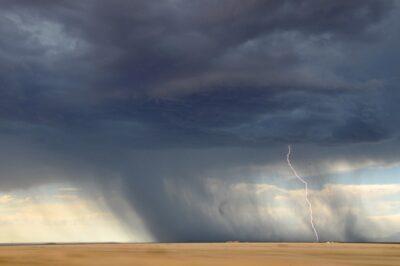|
Listen To The Article
|
Have you been preparing your soil for growing vegetables and other crops in your garden, only to see it washed away in storms? The valuable time and energy you spend – and the compost and manure you are layering into your garden beds — should be protected from rain and wind. What are the best ways to stop soil erosion from taking its cut of your land?
First, discover where the erosion is coming from. If the plot is in an exposed area, wind may be to blame. Check the soil for telltale signs that it is blowing in the direction of the prevailing wind. If you see evidence of this, such as dust blowing in the wind, or trails of soil leading away from the bed and perhaps even drifting against something nearby, you should combat the soil erosion by blocking the wind. In the short term, a fence or wall can keep the wind from plucking away at your soil; over the long term, it makes a lot of sense to reduce the overall wind on your property by growing trees to act as a windbreak. Small plantings near your garden can also be beneficial for blocking the wind at ground level.
Natural Fertilizer Doubles Garden Production
The flow of water is often the culprit, especially on slopes. Water erosion can happen very quickly; a single rainstorm can wash away an entire bed. Signs of erosion caused by water could be trails left as water streamed through the soil, carrying it away, and piles of soil left in lower areas of your property, carried there by the flow.
Each property has its own characteristics, and you will have to assess the source of problems like soil erosion thoroughly to ensure you’re not putting a Band-Aid on a large wound. However, minor soil erosion can be stopped quite easily, protecting your garden. Try one or more of these techniques to keep your soil in place:
1. Mulching
A mulch is a layer of plant material spread across the soil to help it retain moisture, protect it from weeds, and to combat erosion. It is one of the most effective techniques to preserve your soil from the onslaught of both wind and rain. Mulch can be composed of plant material, wood chips, straw, grass clippings or any other spare plant material generated by the homestead. You can spread it across an area of soil before planting, as well as heap it around existing plantings to protect their base and the surrounding topsoil. The mulch acts as a buffer between the earth and the elements.
If a plot will not be used for a season, consider planting a cover crop to act as living mulch. In addition to protecting the soil, the right cover crops can improve the soil nutrients. For winter coverage, try oats, barley or rye in the fall; the dying grains will protect the soil through the fallow season. In summer, buckwheat, clover and wildflowers can attract pollinators while protecting the soil.
2. Edging
Areas that are being affected by water runoff can often be resolved with blocking the flow of water in and out of the bed. Build a retaining wall around small beds and larger plants. Usually, you will place the retaining wall a few inches into the ground and a few inches above it. They will shield your garden from surface water and keep rainwater in the bed.
On a slope, terracing will keep the soil from running downslope during storms. Ensure you measure the contour of the slope before building the terraces, so you will be able to prevent terraces from losing soil to one another.
New Natural Fertilizer Makes Plants Grow Like Crazy
3. Controlling the water
If rain runoff or other flowing water is affecting your property, consider diverting the flow. There are a few techniques to consider that will stop the water before it reaches your soil beds. One of these is rain barrels: Catch water in barrels placed upslope for later use in the garden. You could also create a rain garden upslope from your main plot by planting across the flow of runoff; the plantings will absorb and divert water. For a more involved version of the same idea, you can build a berm (or small hill) covered with plantings in the path of the water, using the raised area to shield your soil beds. Lastly, consider controlling the flow of water with a swale running downslope or buried rocks or gravel channeling water away from your garden.
No matter what methods you use, the work will not be wasted. Your soil is a valuable commodity, and your effort will ensure the viability of your garden.
How have you stopped erosion? Share your tips in the section below:
Every Spring, Gardeners Make This Avoidable Mistake — But You Don’t Have To. Read More Here.
 Off The Grid News Better Ideas For Off The Grid Living
Off The Grid News Better Ideas For Off The Grid Living





